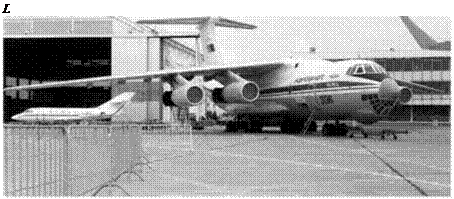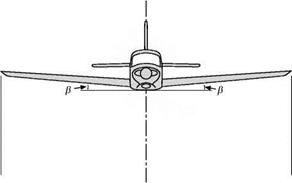Dihedral angle
The most common method of obtaining lateral stability is by the use of a dihedral angle on the main planes (Figs 9.4 and 9A). Dihedral angle is taken as being the angle between each plane and the horizontal, not the total angle between the two planes, which is really the geometrical meaning of dihedral angle. If the planes are inclined upwards towards the wing tips, the dihedral is positive; if downwards, it is negative and called anhedral (Fig. 9B, overleaf); the latter arrangement is used in practice for reasons of dynamic stability.
The effect of the dihedral angle in securing lateral stability is sometimes dismissed by saying that if one wing tip drops the horizontal equivalent on that wing is increased and therefore the lift is increased, whereas the horizontal equivalent and the lift of the wing which rises is decreased, therefore obviously the forces will tend to right the aeroplane.
Unfortunately, it is not all quite so obvious as that.
Once the aircraft has stopped rolling, and provided it is still travelling straight ahead, the aerodynamic forces will be influenced only by the airstream passing over the aircraft. This will be identical for both wings and so no restoring moment will result.
What, then, is the real explanation as to why a dihedral angle is an aid to lateral stability? When the wings are both equally inclined the resultant lift on the wings is vertically upwards and will exactly balance the weight. If, however, one wing becomes lower than the other (Fig. 9.5), then the resultant lift on the wings will be slightly inclined in the direction of the lower wing, while the weight will remain vertical. Therefore the two forces will not
|
|
|
|
|


balance each other and there will be a small resultant force acting in a sideways and downwards direction. This force is temporarily unbalanced and therefore the aeroplane will move in the direction of this force – i. e. it will sideslip (Fig 9.6) – and this will cause a flow of air in the opposite direction to the slip. This has the effect of increasing the angle of attack of the lower plane and increasing that of the upper plane. The lower plane will therefore produce more lift and a restoring moment will result. Also the wing tip of the lower plane will become, as it were, the leading edge so far as the slip is concerned; and just as the centre of pressure across the chord is nearer the leading edge, so the centre of the pressure distribution along the span will now be on the lower plane; for both these reasons the lower plane will receive more lift, and after a slight slip sideways the aeroplane will roll back into its proper position. As a matter of fact, owing to the protection of the fuselage, it is probable that the flow of air created by the sideslip will not reach a large portion of the raised wing at all; this depends very much on the position of the wing relative to the fuselage.

Both the leading edge effect on the lower wing, and the shielding of the upper wing by the fuselage, occur on nearly all types of aircraft, and may well mean that an aeroplane has a sufficient degree of lateral stability without any dihedral angle, or too much if some of the following effects also apply. Even if there is no actual dihedral angle on the wings, these other methods of achieving lateral stability may be described as having a ‘dihedral effect’.
Fig 9B Anhedral
Like this Ilyushin IL-76, many aircraft with high-mounted swept wings are given a significant amount of anhedral. This is primarily used to counteract the Dutch roll tendency, a form of dynamic instability involving coupled roll and yaw motions.
|
|
Fig 9.6 The production of a sideslip













